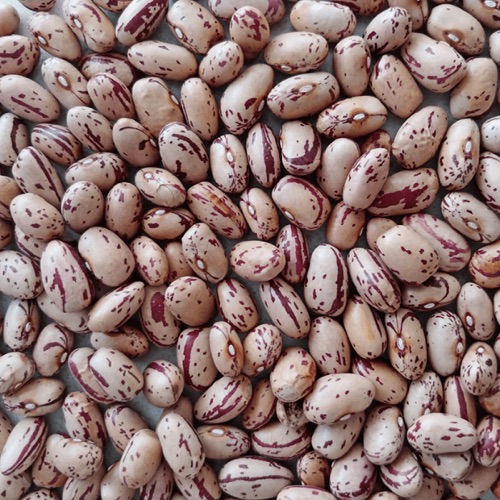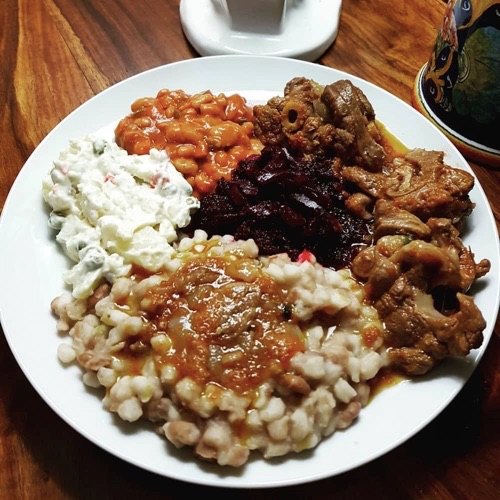Sugar beans, also known as pinto beans, are an incredibly versatile and nutritious legume that has been a staple in many cultures’ diets for thousands of years.
They are believed to have originated in Central and South America, where they have been cultivated and consumed for centuries. Today, sugar beans are grown and enjoyed worldwide, primarily for their delicious taste and impressive nutritional profile.
Sugar beans are small, oval-shaped beans with a pale pink or beige color and a distinct mottled pattern.
They are typically consumed as dried beans, which require soaking and cooking before they can be eaten. They are a popular ingredient in many traditional dishes. This includes soups, stews, casseroles, and salads, and they can be found in various cuisines around the world.
In recent years, sugar beans have gained recognition as a superfood due to their impressive health benefits and nutritional content. This comprehensive guide will explore the various aspects of sugar beans. Including their nutritional profile, health benefits, culinary uses, and more.

Nutritional Profile of Sugar Beans
Sugar beans are an excellent source of nutrients, making them a valuable addition to any diet. They are low in fat, cholesterol-free, and high in dietary fiber, which can promote digestive health and help maintain healthy blood sugar levels.
One cup of cooked sugar beans provides approximately 15 grams of fibre. This is more than half the daily recommended intake for adults.
In addition to fiber, they are also a rich source of plant-based protein. One cup of cooked sugar beans contains roughly 15 grams of protein, making them an ideal option for individuals following vegetarian or vegan diets.
They also provide a wide range of essential vitamins and minerals, including iron, potassium, magnesium, and folate. The high levels of antioxidants found in sugar beans can help protect the body from the harmful effects of free radicals. This can lead to various chronic diseases and premature aging.
Furthermore, they contain a type of carbohydrate known as resistant starch. This has been linked to numerous health benefits, including improved gut health and increased satiety.
Health Benefits of Sugar Beans
The consumption of sugar beans has been associated with numerous health benefits, primarily due to their impressive nutritional content and high levels of antioxidants.
Heart health
Sugar beans are a rich source of dietary fiber and potassium, both of which have been shown to promote heart health.
Fibre can help lower cholesterol levels and maintain healthy blood pressure, while potassium aids in regulating blood pressure and preventing hypertension. Additionally, sugar beans contain antioxidants that can help reduce inflammation, which is a major contributor to cardiovascular disease.
Diabetes management
The high fiber content of sugar beans can help slow the absorption of sugar into the bloodstream and maintain stable blood sugar levels. This makes them an ideal food choice for individuals with diabetes or at risk of developing the condition.
The resistant starch found in sugar beans has also been shown to improve insulin sensitivity, further aiding in blood sugar control.
Digestive health
Sugar beans are an excellent source of dietary fibre, which can promote healthy digestion by adding bulk to stool and preventing constipation.
Furthermore, the resistant starch found in them acts as a prebiotic, feeding the beneficial bacteria in the gut and promoting a healthy gut microbiome.

Culinary Uses of Sugar Beans
Sugar beans are incredibly versatile in the kitchen and can be used in a wide variety of dishes. They have a mild, slightly sweet flavour that pairs well with numerous ingredients. Their creamy texture makes them an excellent addition to soups, stews, and casseroles.
Staple dishes
In many cultures, they are a staple ingredient in traditional dishes. For example, in Mexican cuisine, they are often used in refried beans. While in the American South, they are a key component of Hoppin’ John. This is a dish made with black-eyed peas, rice, and various seasonings.
Salads and Sides
Sugar beans can also be used to add flavour and nutrition to salads and side dishes. They can be tossed with fresh vegetables, herbs, and a simple vinaigrette to create a delicious and healthy bean salad. Or they can be mixed with cooked grains like rice, quinoa, or barley for a hearty side dish.
Dips and Spreads
They can be pureed and combined with various seasonings and ingredients to create delicious dips and spreads.
For example, they can be blended with garlic, lemon juice, and tahini to make a creamy bean dip. Or they can be mixed with salsa and avocado for a flavourful bean and guacamole dip.
How to Cook and Store Sugar Beans
Proper cooking and storage are essential for ensuring that sugar beans are safe to eat and maintain their nutritional value.
Cooking Sugar Beans
Before cooking, dried sugar beans should be thoroughly rinsed and soaked in cold water for several hours or overnight to rehydrate them and reduce their cooking time.
The soaked beans can then be drained, rinsed, and simmered in fresh water or broth until tender. This typically takes between 1 and 2 hours.
When cooking them, it is essential to avoid adding acidic ingredients like tomatoes or vinegar until the beans are fully cooked, as these can cause the beans to become tough and prevent them from softening.
Storing Sugar Beans
Dried sugar beans should be stored in a cool, dry place away from direct sunlight and heat. They can be kept in their original packaging or transferred to an airtight container for optimal storage. Cooked sugar beans can be stored in the refrigerator for up to a week or frozen for up to six months.
In Various Cuisines
Sugar beans are enjoyed in many cuisines around the world, and their versatility makes them a popular ingredient in both traditional and contemporary dishes.
Mexican Cuisine
In Mexican cuisine, they are a staple ingredient and are used in various dishes, including refried beans, bean soup, and burritos. They are often combined with rice, cheese, and seasonings like cumin, oregano, and chili powder to create flavourful and satisfying meals.
Indian Cuisine
Sugar beans are also a popular ingredient in Indian cuisine. Where they are used in dishes like rajma, a spicy bean curry made with tomatoes, onions, and a blend of aromatic spices. They can also be found in various dals, which are thick, stew-like dishes made with legumes, spices, and sometimes vegetables.
Mediterranean Cuisine
In Mediterranean cuisine, sugar beans are often used in salads, stews, and dips. They can be found in dishes like minestrone, a hearty Italian vegetable soup, as well as various bean-based salads and spreads like hummus and baba ganoush.
Growing Sugar Beans at Home
For those interested in growing their food, sugar beans are a relatively easy and low-maintenance crop to cultivate at home. They can be grown in a variety of climates and soil types. This makes them an excellent choice for gardeners of all skill levels.
To grow sugar beans, seeds should be planted in well-draining soil after the last frost of the season, with approximately 2 to 3 inches of space between each seed. The plants will require regular watering and should be provided with support, like a trellis or stake, as they grow taller.
Once the sugar bean plants have produced pods, they can be harvested and either eaten fresh or left to dry on the plant for later use as dried beans.
To store dried beans, the pods should be removed from the plants. The beans should then be allowed to air dry for several days before being stored in an airtight container.

Compared to other Legumes
While sugar beans share many similarities with other legumes, they also possess some unique characteristics that set them apart.
Flavour and Texture
Sugar beans have a slightly sweet flavour and a creamy texture when cooked. This makes them an excellent addition to various dishes. In contrast, other legumes like black beans or chickpeas may have a more earthy or nutty flavour and a firmer texture.
Nutritional Content
All legumes are rich in fiber, protein, and essential vitamins and minerals. But sugar beans boast particularly high levels of antioxidants and resistant starch, which can provide additional health benefits.
Culinary Versatility
Sugar beans can be used in a wide variety of dishes. They are often enjoyed in both sweet and savory preparations.
While other legumes like lentils or kidney beans may be more commonly used in specific types of dishes, sugar beans can be easily adapted to suit various cuisines and recipes.
Recipes Featuring Sugar Beans
There are countless ways to incorporate sugar beans into your diet. Experimenting with new recipes is an excellent way to enjoy their unique flavour and nutritional benefits.
Sugar Bean Chili
A hearty sugar bean chili is a perfect dish for colder months, combining the creamy texture of sugar beans with the rich flavours of tomatoes, bell peppers, onions, and a blend of spices like chili powder, cumin, and smoked paprika.
Sugar Bean and Vegetable Stir-Fry
For a lighter and more healthful meal, sugar beans can be combined with a variety of fresh vegetables and a flavourful sauce to create a delicious stir-fry. Feel free to customise the dish with your favourite vegetables and seasonings for a meal that suits your tastes.
Sugar Bean Curry
A fragrant sugar bean curry is a satisfying and nutritious dish that showcases the versatility of sugar beans. The creamy beans pair beautifully with tender spinach and the spicy, aromatic flavours of the curry.
In Summary
Sugar beans are a versatile and nutritious superfood that can be easily incorporated into a variety of dishes. Their impressive nutritional profile and numerous health benefits make them a valuable addition to any diet.
Whether you’re growing them in your garden or experimenting with new recipes in the kitchen, this comprehensive guide to sugar beans will help you make the most of this delicious and healthful legume.



